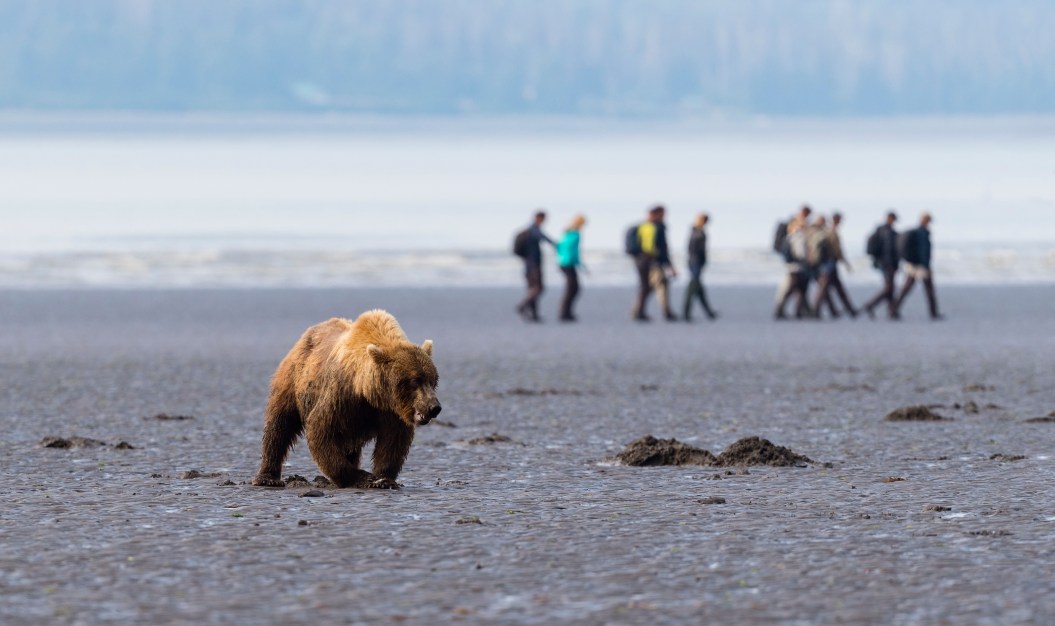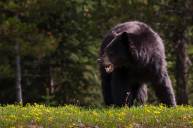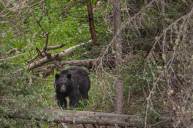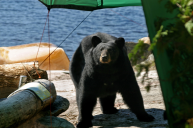It's something most anglers may not consider when heading to a remote fishing spot: Many of America's best fishing spots are also great places to see bears. Black bears range across many of the country's forested regions; and if you're bushwhacking through Alaska or parts of Montana and Wyoming to go fishing, the odds are relatively decent you'll be sharing terrain with a grizzly or two.
Every year there are headlines of hikers, hunters, and anglers who have unexpected interactions with bears. Often, the people were not aware of proper safety while in bear country or responded poorly to a close encounter. Sometimes, the stories have happy endings: The people were bluff-charged or managed to turn away a charging bear with the help of bear spray. Other times, the ending was not so happy.
Anglers, and particularly trout and salmon fishers, are particularly at risk in bear country. They are, after all, competing with bears for a favorite food source. That's why so many seasoned Western and Alaskan anglers (myself included) have a specific bear safety plan for every fishing trip. No two bears, and no two bear encounters, are the same—especially while fishing. A few vital tips apply all the time. Here's how to be prepared for bears while fishing.
Black Bears and Grizzly Bears in the U.S.
In the United States and Canada, the bear species you'll find are black bears and brown (grizzly) bears.
Black bears are the more common species. Approximately 600,000 live across North America, mostly in forested and mountainous areas—especially in the Appalachians in the East and the Rocky Mountains in the West. Black bears have a much wider geographic range, are found all across North America, and tend to be more nuisance bears—getting into garbage and causing minor disturbances.
Brown bears, which include grizzlies, live in fewer locations but are far larger and can be scarier. Grizzly bears are found in Alaska, Wyoming, Montana, Idaho, Washington, and possibly southern Colorado, as well as in western Canada.
Both black and brown bears keep busy during the summer months, which are also the months when the highest numbers of humans venture into their terrain. The largest omnivores in North America, bears hibernate during the winter months when their food sources are scarce, so they must feast in the warmer months, storing enough fat to see them through the long winter slumber ahead.
But during the fall, when they're at the tail end of beefing up for the winter hibernation—which, of course, coincides with prime fishing season—bears are especially active and can become threatening.
The Basics of Bear Safety While Fishing
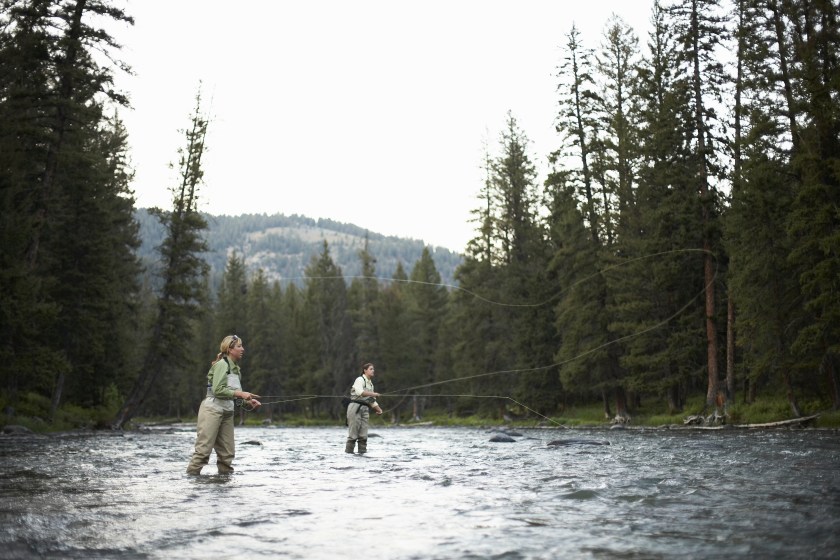
Getty Images, Stuart Sutton
The safety basics in bear country are fairly intuitive. Many times, bears will be spooked away if they hear you, and you'll never even know they're in the area.
- Bring friends. A few chatty friends (or at least your dog) can make smart companions if you ever hike to a river or lake in bear country. Talk and make noise while you walk. If you're alone, bear bells are extremely useful for making your presence known.
- Post a scout. In deep bear country, many fishing groups post a friend on watch while the others fish. This is a great way to rotate in and out of fishing holes while someone rests, has a drink, and keeps an eye out for critters.
- Keep your eyes open. Understand that a bear can charge at any time. A best practice is to be "bear aware"—don't get fixated on watching your fly or lure. Look around every few minutes to study your surroundings and ensure a bear's not walking up on you. If possible, fish in open areas where you have a decent line of sight. This will also help bears see you.
- Carry bear spray. It's a good idea to carry bear spray (more on that below). If you can't grab it in a second or two, it's not going to help.
- Cut the line. If you have a fish on the line and a bear approaches—not the most uncommon thing when fishing in Alaska, where I live—cut the line or let the fish slip off. Back out of the water and head toward an open area or the rest of your group. The goal is to avoid interaction with the bear; and because it was likely drawn to the splashing of your fish, the bear should lose interest in you once the fish is off the line.
- Watch your scents. It's no secret that bears are drawn to scent. If you choose to keep fish, store them in sealed plastic bags and a bear-proof container, well away from your campsite or cabin. If you're going home for the night, wait to filet fish at home to avoid spreading its scent around the area. Bears love carcasses, so leaving a pile of fish debris is a good way to draw in bears that might cause a problem for the next angler.
- Be aware while wading. It should come as no surprise that bears can cross rivers. If you happen to come across one, don't assume you'll automatically be safe if you wade into the river. An aggressive bear will have no problem coming after you in the water.
What to Do if You See a Bear
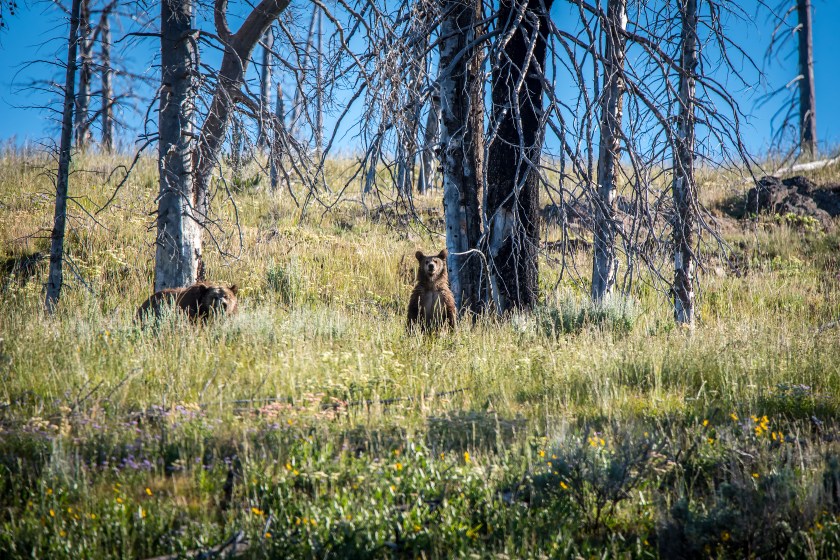
Getty Images, John Morrison
Bears tend to be most active in the morning and evening hours when the air is cooler, but they can be seen on the move during any time of day.
- If you see bears, don't crowd them. Give them plenty of space—don't run away, but give them room to vacate the area—and stay out of their way.
- Stay calm but make noise. Most bears don't want a confrontation and will be just as surprised by you as you are by them.
Dealing With an Aggressive Bear
Sometimes, you can do everything right and a bear may still become aggressive. Maybe it's a sow with cubs nearby, maybe you're between the bear and where it means to go, or perhaps it's just a nuisance bear with a history of aggressive behavior. Bears are individuals, after all, and it's never safe to assume that you know how the interaction will go.
- If you find yourself facing an aggressive bear, remain calm. Never, ever run. Running is the motion of prey and will confirm to the bear that you're something to be chased. Its natural instinct will kick in, and there's no way you can outrun a charging bear.
- Start by talking to the bear in a normal, conversational voice. Let it know you're a human.
- If the bear continues to draw closer, ratchet it up a notch and get a bit more defensive. Make your profile larger by waving your arms, and raise your voice. If you're with friends, gather together and shout. Think about making yourselves big and intimidating.
- If the bear starts to turn away, don't turn your back and run. Instead, back away slowly, maintaining a defensive posture, and ensure you're leaving the bear a clear way out of the situation. Unless it's an overly aggressive nuisance bear, odds are good that it's just as ready as you are to get out of the confrontation.
How to Use Bear Spray
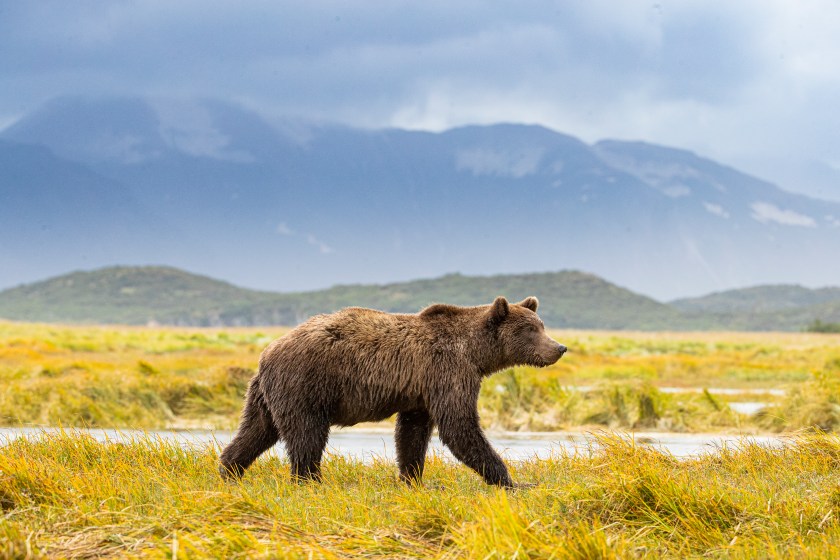
Getty Images, Dennis Stogsdill
When a bear gets aggressive, bear spray has proved to be an effective deterrent, with an estimated 90 to 94 percent efficacy, depending on which report you read. (Either number is a vast improvement over the zero percent efficacy if you're carrying nothing and a bear charges.)
Remember: You must be uncomfortably close to the bear to give it a full blast in the face with your bear spray. Bear spray is most effective at a range of 20 to 30 feet, though some biologists say it's tested most effective at ranges under 20 feet.
The National Park Service offers some tips, as well as a step-by-step tutorial, on how to properly use bear spray in case of an interaction.
- You don't have to be a good shot with bear spray. Just put up a cloud of spray between you and the charging bear.
- Practice! Use an inert can of bear spray to practice removing it from your holster, removing the safety tab with your thumb, and firing. Practice firing inert bear spray with the wind at your back, into a headwind, and with a crosswind so that you understand how bear spray is affected by the wind.
- Do not use bear spray like insect repellent. It does not work as a deterrent when applied to people or equipment.
- No bear deterrent is 100 percent effective: Learn how to reduce your risk while hiking in bear country.
- Make sure your bear spray is EPA-approved; don't depend on personal defense products to stop a charging bear.
- Bear spray can explode if it reaches 120 degrees Fahrenheit. Don't store it in the passenger compartment of vehicles or near any heat sources.
- Make sure your bear spray hasn't expired.
When Bear Spray Doesn't Work
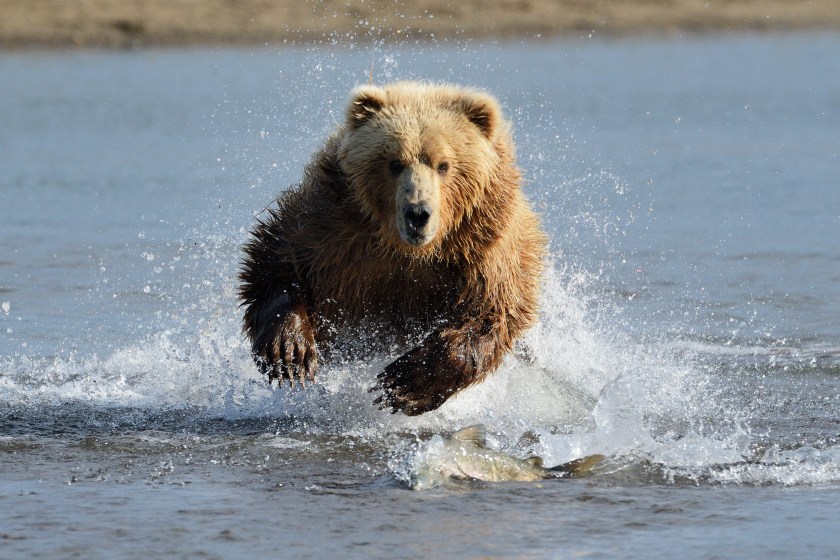
Getty Images, AndreAnita
So what if worse comes to worst and your bear spray doesn't work, and suddenly a bear is on top of you? You've got two choices: Play dead or fight back.
If the bear is acting in defense—defending cubs or a food source—playing dead may be your best call. According to the National Park Service, this tends to be the best strategy for most grizzly attacks:
- Lie face down on the ground and cup your hands behind your neck.
- Remain calm and still. If the bear believes the "threat" is neutralized, it may leave you alone.
- Don't move until the bear backs off and leaves the area, as fresh movement may draw it in again.
If the aggressor is a black bear instead of a grizzly looking for trouble—black bears are most commonly trying to steal food—go ahead and fight back. If you can make it decide the food isn't worth getting past a hard target, it's likely to back off.
Should You Carry a Gun While Fishing in Bear Country?
Many anglers—me included—carry a sidearm when in bear country and have taken the time and training in order to do so safely and responsibly.
It's a bad idea for someone unfamiliar with firearms to go buy a handgun off the shelf and carry it as protection against bears without any training or work to familiarize themselves with gun safety and proper handling. Even for individuals familiar with firearms and hunting, effectively using a pistol in a tight-quarters, rapidly evolving situation with a charging bear is difficult. The risk of merely wounding the bear is significant, which in turn could make the bear more aggressive.
If you're trained and confident carrying a sidearm, the decision is something to consider. Talk with local fish and game commission about its recommendations for ammunition and safe carry, and never shoot at a target of which you are uncertain. The basics of safe firearm handling always apply: Treat every gun as if it were loaded, know what you are shooting at, and use common sense. For some anglers, carrying a firearm provides peace of mind that, should the worst happen and a bear not break off a charge when sprayed with bear spray, they have another alternative.
Carrying a firearm at any time is a very personal decision and should not be taken lightly. If you choose to carry in bear country, be a responsible gun owner and do so wisely. As with bear spray, you should keep your weapon readily accessible and easy to reach. When things go south, they tend to do so quickly.
READ MORE: How to Identify Bear Scat from Black Bears or Grizzly Bears
